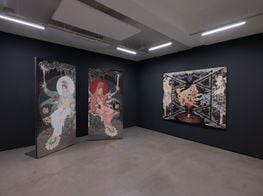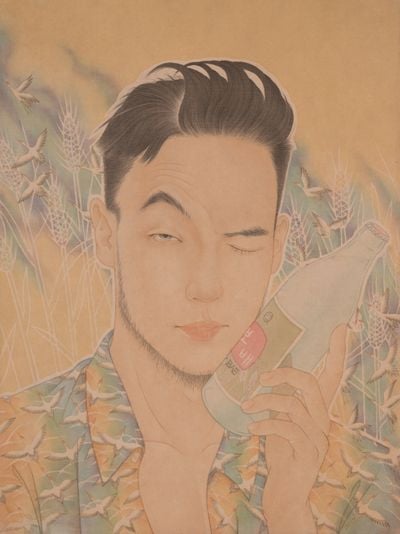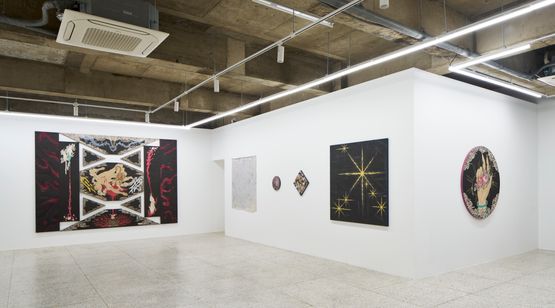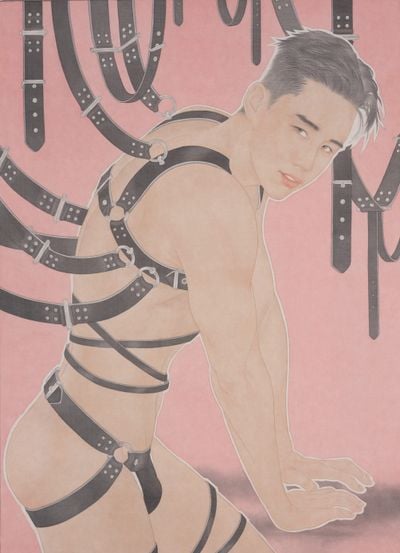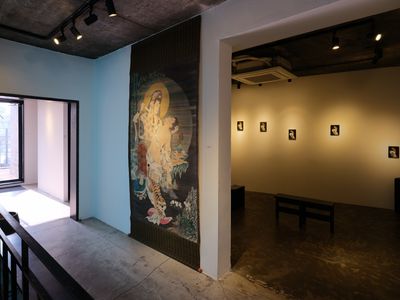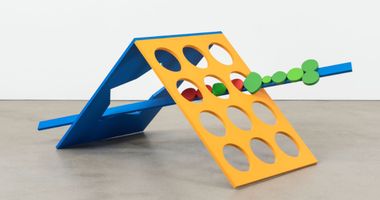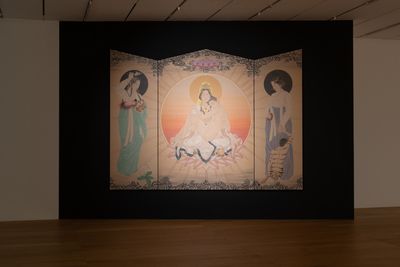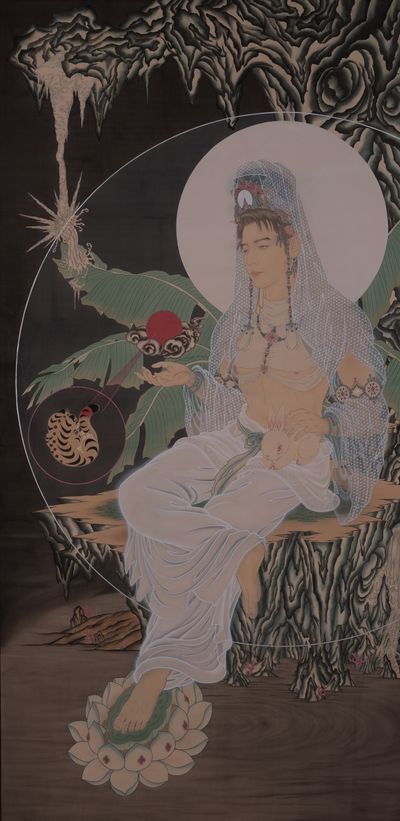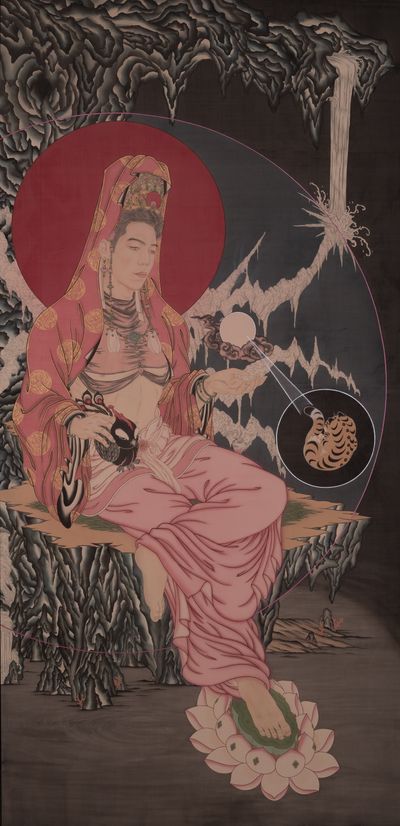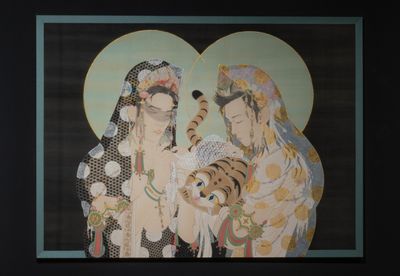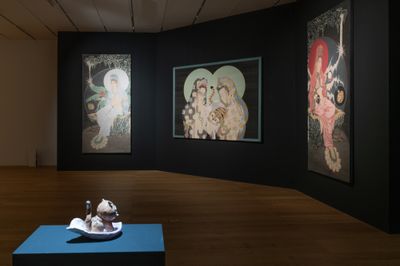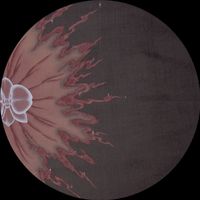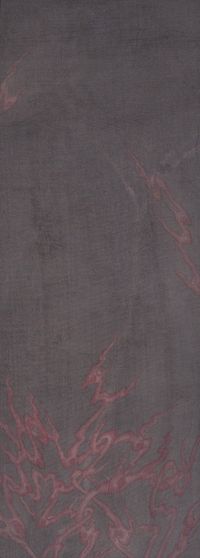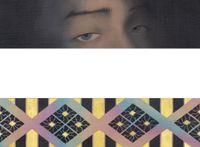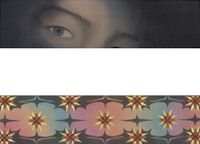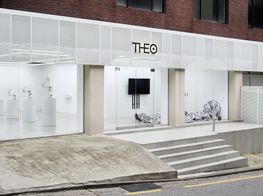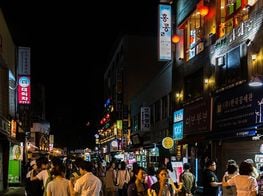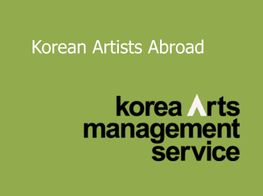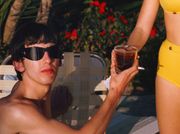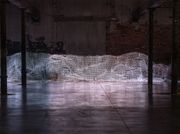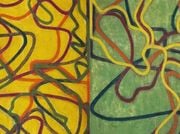Grim Park on Rethinking Traditions of Korean Painting
IN PARTNERSHIP WITH KOREA ARTS MANAGEMENT SERVICE
Grim Park. Courtesy the Artist.
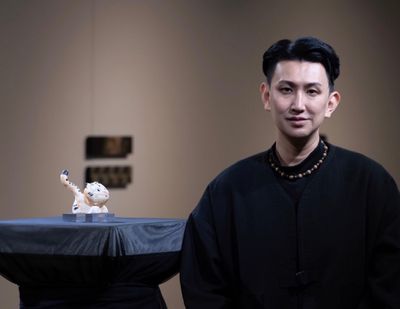
Grim Park. Courtesy the Artist.
Artist Grim Park met with me at Gallery THEO on a clear day in June, just before Seoul descended into its infamous heat. Park has a studio on the gallery's second floor: a modest space packed with canvases and cabinets, and an unusually high ceiling that the artist renovated to accommodate his larger paintings.
Huddled around a small table, we—including Hyun Min Kim, director of THEO—chatted through Park's works from his early days studying taenghwa (Buddhist hanging painting) in the traditional apprentice system, to his latest projects.
Park apprenticed for three years before enrolling in the Buddhist-affiliated Dongguk University in 2012. Upon graduation in 2016, he went on to participate in a number of taenghwa projects while developing his distinctive approach to painting that combines traditional Buddhist painting techniques with contemporary and queer sensibilities.
Influential to his early practice were the pictures of attractive queer men that he encountered on social media, inspiring works like I SLAY (2016), a portrait of a winking man holding up a bottle of soju to his face, and Dirty? Beauty!? (2018), in which another young man in harnesses poses boldly against a pale pink background.
Both works belong to 'Hwarangdo' (2015–2018), whose title borrows from Hwarang or Flowering Knights, an elite group of warriors in Silla, an ancient Korean kingdom, who were lauded for their youth, bravery, and beauty. Park paints his Flowering Knights using the traditional damchae technique (ink-and-wash painting), patiently layering paint on paint above a silk canvas, which produces the soft contours and colourations that now characterise his practice.
Park's 'Hwarangdo' paintings were first exhibited as a series in 2018 at Beobryeonsa, a Buddhist temple in Seoul, under the title HWARANGDO (花郞徒) – A crowd of beautiful men. Despite South Korea's conservatism towards both homosexuality and overt displays of male eroticism, Park's debut solo exhibition was met with mostly favourable views from audiences.
Korea nevertheless remains an unwaveringly conservative country, and it is no surprise that the act of naming and the subtle nuances of the Korean language have been particularly meaningful for Park. In 2017, the artist changed his legal name to 'Grim'—a term broadly used for pictures, paintings, and drawings—in a self-assigned ritual of marking his beginning as a full-time contemporary artist.
Horo (虎路), the title of Park's latest solo exhibition at Studio Concrete, Seoul (2022), means Tiger's Way; in colloquial Korean, it is associated with derogatory terms about gay men.
Following 'Hwarangdo', Park increasingly turned towards the self in 'Shimhodo (尋虎圖)' ('Painting of Searching for a Tiger') (2018–ongoing). The series is his contemporary take on the Buddhist fable Shimwoodo, an illustrated tale of a monk's search for enlightenment with a bull.
'Shimhodo' revolves around a small tiger, painted in a style reminiscent of Joseon period paintings with diamond pupils and prominent fangs, who traverses lands and meets bodhisattvas. The animal is held by two deities in Shimhodo – Chosen (2018), draped in an exquisite, rainbow-coloured veil. Among the many meanings of Chosen in Korean, Park selected 揀擇 (gantek) for his painting, which stresses choosing what is necessary and in moderation for oneself.
In Shimhodo_Amrita (2021), a large painting made of shaped canvases, a tiger feeds on a man's body—its former self—in a process of destruction and rebirth. Park perceives the tiger as his persona, serving as an allegory for a traveller on a journey of self-discovery.
A new version of Shimhodo – Chosen is among Park's works at SONGEUN, Seoul, as part of the group exhibition PANORAMA (16 August–28 October 2023). In this version, the bodhisattvas become the focal point, prominent against the opaque black background. A blue frame has also been painted around the canvas, like a window, beyond which perhaps lies the tiger's next destination.
In the following interview, Park discusses renaming himself, carving out a space for Buddhist painting within contemporary art, and the arduous, perpetual process of discovering oneself.
SPIn 2017, you changed your official name to 'Grim'. What prompted this decision?
GPI've been fond of grim ever since I was a child, but the more I pursued it, the more complicated things got for me. I wanted to challenge myself to create contemporary art with Buddhist art, which is a rather minor branch of painting, and become part of the Korean art world.
That meant breaking off from my melancholic past and starting afresh, which led me to change my name. Not that things have been easy afterwards, but I'm here now thanks to Buddha's compassion.
SPTaenghwa is a very specific niche of painting within Korean traditional art, and you initially chose to study it via apprenticeship before deciding to attend university. What led you down this road?
GPI crossed paths with a teacher who paints taenghwa and became his apprentice. The very first time I saw his paintings, I felt a thrill that I had never experienced before.
My teacher was a recluse, but he wanted me to approach Buddhist art with a greater knowledge of the world. He recommended that I enrol in a university, which I did.
SPWhat prompted you to experiment with contemporary themes?
GPThe taenghwa genre has a set of entrenched traditions inherited from the past. Everything follows a rule, be it a buddha or bodhisattva's iconography or the placement of colours. I wanted to contribute to Buddhist art by taking down these conventional methods.
What I do is a kind of taenghwa that is specific to the time and place to which I belong. Buddhist art in Korea changed, succeeded, and structured itself throughout time from the Goryeo to Joseon periods. I hope that it continues into the distant future like my contemporary vision of Buddhist art.
SPCould you elaborate on the 'Hwarangdo' series, which was first exhibited at a Buddhist temple in 2018?
GP'Hwarangdo' began as an attempt to overcome self-hatred and ameliorate prejudices against minorities in contemporary society by deifying them in painting. Having lived as a gay man, I suffered from negative narcissism—there were the physical changes I didn't like that began in my adolescence and others belittling my appearance. I lost confidence and even began to hurt my face.
Around that time, social media took off and I got to meet people who are the same as me. They proudly showed off their beauty and shared their fancies and lifestyles. I looked up to them for their unapologetic display of who they are, which is something I had always tried to hide.
'Hwarangdo' comes from that: trying to own the beauty of self-love that I don't have indirectly through my paintings. The series also seeks ways to break down Korean society's stereotypes about gay men.
SPCould you introduce the works you'll be showing in PANORAMA? How will your new work be placed in relation to your older paintings? What were the challenges?
GPWorks from 'Shimhodo' will be on view. The series merges elements from the Buddhist fable Shimwoodo with my personal narrative. It explores the reinterpretation of traditional painting in a contemporary context and the process of familiarising it using characteristics of religious painting.
The exhibition includes Shimhodo – Sunlight and Moonlight (both 2022), which prompt thinking about the human interior and exterior, and Shimhodo – Seraphic Shine (2022), meant as a consolation for parents whose children are queer.
'Panorama' made me think of the word jumadeung (phantasmagoria). We commonly use it to describe ephemeral objects or when we reflect on time that's passed in the blink of an eye. I was curious about what Shimhodo – Chosen, the first of the 'Shimhodo' series, would look like if I remade it after five years. You could say creating a new version of a five-year-old painting was a challenge.
When you step into the space you'll see three paintings—Shimhodo – Sunlight and Moonlight flanking the new Shimhodo – Chosen—and a ceramic tiger facing them. His name is Hogu. He's meant to replace or overcome negativities and I hope you get to experience, even if partially, what it's like to meet the bodhisattvas in Shimhodo and travel towards enlightenment with Hogu as your companion.
SPWhat's next for the tiger? Do you have any long-term goals or projects?
GPSimhodo's tiger would want to reach enlightenment and attain Buddhahood, right? He'd work hard to achieve that goal. I'd also like to collect my works into an art book. —[O]

